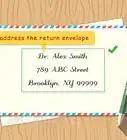This article was co-authored by Hovik Harutyunyan. Hovik Harutyunyan is an Event and Wedding Planner and the Owner of Hovik Harutyunyan Events, a full-service event planning firm based in Los Angeles, California. Hovik has over ten years of hospitality and event planning experience. His firm specializes in weddings, private celebrations, and corporate events. Hovik's work has been featured in Vogue, Martha Stewart Weddings, and Modern Luxury Weddings. He has a BA in Economics from the University of California, Berkeley.
There are 19 references cited in this article, which can be found at the bottom of the page.
This article has been viewed 116,050 times.
When planning a wedding or other large party, keeping count of how many guests will attend and what their meal choices are is especially important so that you may plan appropriately. Most people gather this information by including printed response cards with their invitations. Response cards are identified by their smaller size and are usually accompanied by a small, pre-addressed envelope so that guests can return the card. Etiquette rules apply when you address response card envelopes and vary depending on how formal or traditional your wedding or party is.
Steps
Addressing Response Cards for Your Event
-
1Address the response cards to yourself. The response cards are exactly that – a response – and so must be addressed to you so that your guests can simply stick the card in the envelope and put it in the post. While the invitation envelope is addressed and mailed to the invited guests, the response card will be sent to you, or whoever you designate to be in charge of collecting responses.[1]
- Use the guest’s address for the return address so that they will receive the response card back if there is a problem with the mail.
- Because response card envelopes tend to be much smaller than invitation envelopes, you can instruct your calligrapher or printing service to print the guest’s address on the envelope’s back flap, leaving only your address on the front of the envelope.
-
2Decide which return address to use. The return address on your address cards may differ from the one on your invitations because someone may be hosting one event and someone hosting another, such as a wedding and the reception. Typically, whoever is hosting the event will receive the response cards and their address should be used as the return address.[2]
- In formal and traditional weddings, this is usually the bride's parents' residence. Many modern couples have them sent to whomever is primarily responsible for tracking RSVPs and communicating with wedding vendors.
Advertisement -
3Choose how to address recipients. How you address recipients can set the tone for your event. If you address them more formally or traditionally, this signals that your event is likely formal or traditional. Similarly, a more contemporary method of address may indicate a less formal or more contemporary event. Whatever you choose, verify that you have the spelling of each name correct before you begin filling out envelopes.[3]
- If you prefer to be less formal or more contemporary, you may simply write the attendees first and last names on the envelope – “John and Kim Washington”.
- The traditional wording is "Mr. and Mrs. John Smith," or “The Smith Family."
-
4Don’t use nicknames. Whether your event is traditional, formal, contemporary, or informal, you want to avoid using guests’ nicknames or initials. It’s fine to use these names in conversation, but not for an event, no matter how formal or informal it may be.[4]
- The only exception to this rule is if one of your guests strictly goes by an initial and then a last name. For example, “W. Daniel Johnson” would be acceptable if they only go by that name professionally and personally, with no exceptions.
-
5Use professional titles if appropriate. If your guest has a professional title, use this title in your address. Examples of professional titles include Dr., Esq., and Sergeant. You won’t abbreviate these titles in the address; instead, you’ll spell them out, just as you will with the addresses.[5]
- If your guest has a professional title and their companion doesn’t, you’ll still use the appropriate professional and social titles – “Doctor and Mr Sanchez” or “Colonel and Mrs. Brown”
- If both of your guests hold the same professional title, you’ll simply write “Doctors Cantello”
-
6Use appropriate social titles. When addressing your response cards, use appropriate social titles if no professional title is being used. The traditional social forms of address are Mr., Mrs., Ms., and Miss.[6] Some of your guests may not be comfortable with these gendered forms of social address and might prefer a gender-neutral title.[7]
- Mr. is the social address used for men, unless they have a professional designation.
- Miss indicates an unmarried woman.
- Mrs. indicates a married woman.
- Ms. is often used professionally by women, and also is used frequently by women who prefer their social address be unrelated to their marital status.
- There is a lengthy list of gender-neutral forms of address. Find out what your guest’s preference and use that title.
- Follow the same rules of address for same-sex couples, basing your decision on shared or different last names and professional titles.[8]
-
7Use both last names. While many of your guests will share last names, it is likely that many won’t. If you’re sending a response card to a couple with different last names, simply write out both names. It would be seen as disrespectful to send separate invitations rather than put one couple on the same response card.[9]
- For couples with different last names, write out both names – “Mr. Ezra Houston and Ms. Sam Pirkle”.
- You don’t need to fill in names on the response cards themselves. Instead, write a capital letter M followed by a long line “M____________________________”. This allows attendees to fill in their own information as they’d prefer it be written.
Including Essential Information
-
1Determine the RSVP date. All response cards should have an RSVP date, which is the date that you want guests to respond by. Typically your RSVP date should be three or four weeks before the event so that you have plenty of time to make seating charts and give a final head count to the caterers.[10] [11]
- Contact anyone who hasn’t responded via phone or email and ask them to follow up on your conversation by returning the printed card so that you can keep everything organized.
- There are several ways to word this section, such as, “Kindly reply by May 3, 2016” or “RSVP by 5/3/16,” or you might even have fun with it by saying, “Respond by 5/3 or forever hold your peace.”
-
2Leave a space for names. You not only want an accurate head count, but you want to make sure that you know the name of every person attending your function. How you handle this will be dictated, in part, by the formality of your event. At the minimum, though, make sure that you leave a space so that guests may write out their names on the card.[12]
- This is also helpful because it ensures that you have the correct spelling of everyone’s name.
-
3Ask if they’ll be attending. Every response card should have a space for guests to accept or decline your invitation. Again, how you word this will be informed by the formality of your event and your personal preference. At the minimum, though, you want to know if they are coming and how many people will be in their group.[13]
- Etiquette says that only those invited by name should expect to attend; however, some guests assume that they can bring their children, partners, or other guests. One clever way to avoid this is to write, “_____ seats are reserved for your party.” Then, simply fill in the space when you address the card so that it’s clear exactly how many people you’re inviting.[14] [15]
- If you’re inviting specific guests to multiple events, such as a rehearsal dinner, wedding, and reception, include a response card for each event so that you can keep everything organized.[16]
-
4Ask about entrée preferences. The response card is the perfect opportunity to ask your guests what entrée they would prefer. Of course, this is only applicable if you’re planning on offering options. If you’re opting to offer the same meal to all guests, have a buffet-style meal, or serve hors d’oeuvres, you might leave this section off altogether.[17]
- You can also include a space for dietary restrictions here, if you plan to accommodate them.
Printing and Sending the Cards
-
1Decide on card style. Traditionally, a response card is returned in an enclosed, stamped envelope. To save money on printing and postage, and to reduce paper consumption, many people are opting for a postcard-style response card instead. A more formal or traditional event will almost certainly call for an envelope, whereas more contemporary or less formal events may work well with a postcard style response card.[18]
-
2Print the address response cards. In addition to deciding whether you want a postcard or envelope system, you also need to decide if you want to print or hand letter your cards, typically written in calligraphy. It is useful to remember that the print on your invitations should match the print on your cards, which may inform your decision to print or hand letter one way or another.[19]
- If you are planning a wedding and it is formal, all of your stationery should be professionally hand-scribed. Etiquette is more lax with semi-formal and informal weddings, and many brides use their own penmanship, or labels printed from their computers.
-
3Hire a calligrapher. If you prefer a personal touch and opt to have your invitations and return cards hand lettered, consider hiring a calligrapher. Even if you’re proficient in calligraphy, hiring a trained calligrapher can save you time and aggravation, freeing you up to focus on your event. Of course, there are considerations that go into hiring someone to hand letter your correspondence for you.[20] [21]
- Your budget. Calligraphers usually charge between $2-$5 per envelope, although the price may be higher if you have special requests.
- Your schedule. Begin looking for a calligrapher as early as possible. The quicker the turnaround, the more expensive the service will be.
- Your style preference. Every calligrapher has their own style. Look at several calligraphers and decide whose style you like most.
- Your area. Whether you’re from a large city or not, look outside your area for calligraphers. This is especially easy with the internet.
- Recommendations from wedding planners, event organizers, or word-of-mouth.
-
4Printing your response cards. If you opt to print your cards rather than hand scribe them, you’ll need to decide if you want to print them at home or have them professionally printed. If you choose to print them at home, you’ll need to purchase a few items beforehand. If you opt to have them printed professionally, discuss stationery and font options with your printer before designing your invitations and response cards.[22]
- If printing at home, you’ll need a computer, a desktop publishing program, stationery, a working printer, and plenty of printer ink.
-
5Pay for postage. Whether you choose to pay for postage of the response cards is your decision. Some people believe that they should not be required to pay for postage because they’ll be paying for the event, and others feel that the hosts should pay for postage as a courtesy. Ultimately, you must decide if postage is within your budget and if you agree that it’s your responsibility.[23]
- You will likely receive more returned response cards if you include postage.
- Place a stamp on the top right corner of each response card envelope or postcard.
Community Q&A
-
QuestionShould R.S.V.P. cards be inside or outside their own envelopes?
 Community AnswerWhen you mail your invitations, response cards will be tucked under the flap of the envelope in which guests are to send their responses.
Community AnswerWhen you mail your invitations, response cards will be tucked under the flap of the envelope in which guests are to send their responses. -
QuestionIs it incorrect to put "Mrs. John Doe" as the recipient if both parents are married or is the proper way "Mr. and Mrs. John Doe?
 Community AnswerThis is largely up to your discretion, although a formal or traditional envelope addressed to a married couple will read, "Mr. and Mrs. John Doe." Traditionally, you would only address a recipient as Mrs. independently if she is widowed or divorced.
Community AnswerThis is largely up to your discretion, although a formal or traditional envelope addressed to a married couple will read, "Mr. and Mrs. John Doe." Traditionally, you would only address a recipient as Mrs. independently if she is widowed or divorced. -
QuestionCan the return address be placed on the back flap of the envelope?
 Community AnswerAbsolutely! In fact, because the response card envelopes are smaller, it might be best for you to place the return address on the back flap.
Community AnswerAbsolutely! In fact, because the response card envelopes are smaller, it might be best for you to place the return address on the back flap.
References
- ↑ http://www.marthastewartweddings.com/225425/addressing-and-mailing-invitations
- ↑ http://emilypost.com/advice/addressing-sending-wedding-invitations/
- ↑ http://soireesignatures.com/addressing-etiquette/
- ↑ http://www.marthastewartweddings.com/225425/addressing-and-mailing-invitations
- ↑ http://www.marthastewartweddings.com/225425/addressing-and-mailing-invitations
- ↑ http://www.formsofaddress.info/Social_M_W.html
- ↑ https://writingcenter.unc.edu/tips-and-tools/gender-inclusive-language/
- ↑ https://www.theknot.com/content/addressing-wedding-invitations
- ↑ http://www.marthastewartweddings.com/225425/addressing-and-mailing-invitations
- ↑ http://theeverylastdetail.com/stationery-week-rsvp-card-insight/
- ↑ Hovik Harutyunyan. Event & Wedding Planner. Expert Interview. 21 February 2020.
- ↑ http://emilypost.com/advice/how-to-word-a-wedding-response-card/
- ↑ http://emilypost.com/advice/how-to-word-a-wedding-response-card/
- ↑ http://www.reception-wedding.com/wedding_response_card_wording.htm
- ↑ https://www.theknot.com/content/wedding-invitations-etiquette
- ↑ http://www.glamour.com/story/what-you-should-and-absolutely
- ↑ https://rsvpify.com/wedding-rsvp-wording/
- ↑ http://theeverylastdetail.com/stationery-week-rsvp-card-insight/
- ↑ https://www.theknot.com/content/wedding-calligraphy-basics
- ↑ http://bridalmusings.com/2015/04/hiring-a-wedding-calligrapher/
- ↑ https://www.theknot.com/content/wedding-calligraphy-basics
- ↑ http://apracticalwedding.com/2011/04/how-to-print-your-own-wedding-invitations/
- ↑ http://soireesignatures.com/addressing-etiquette/
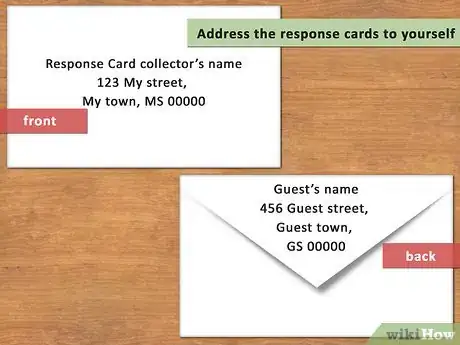
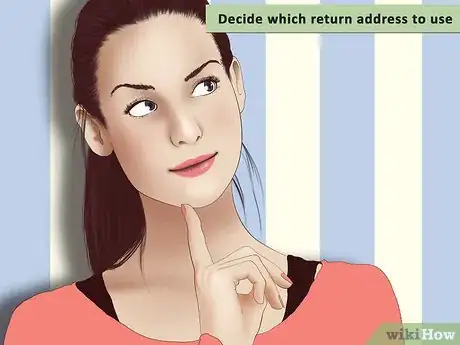
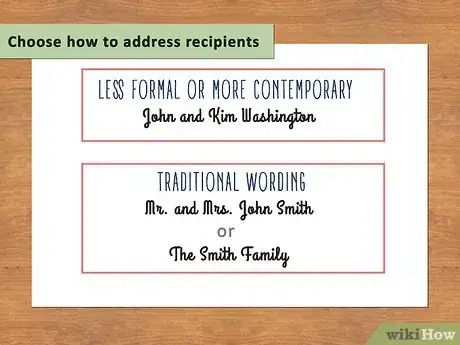
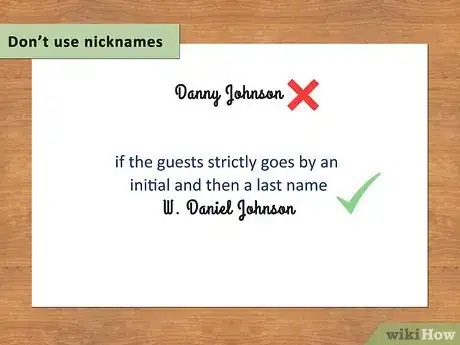

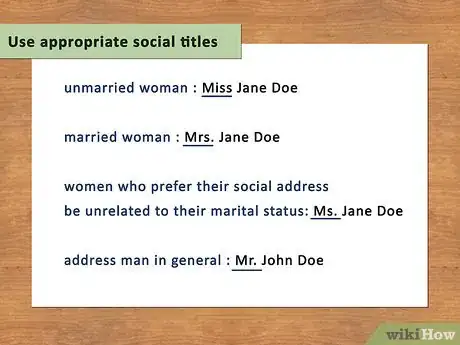

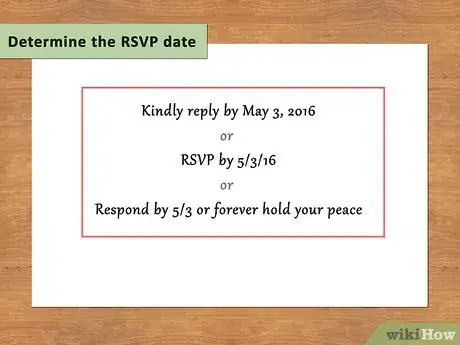

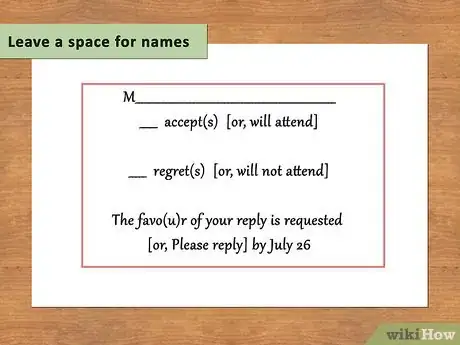
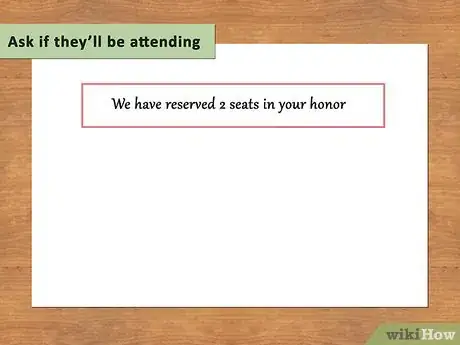
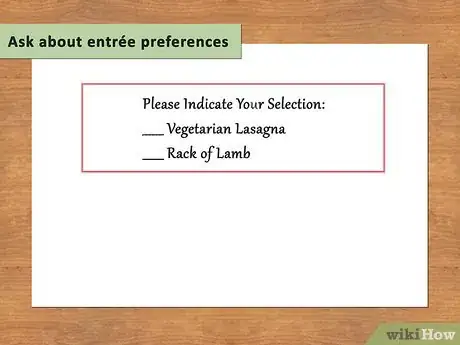
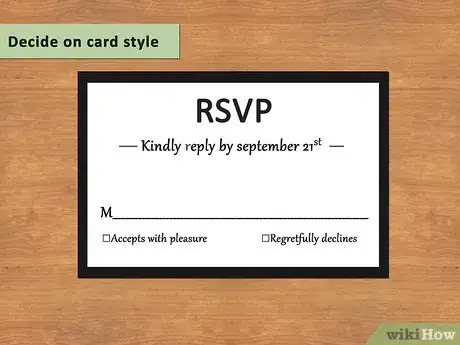
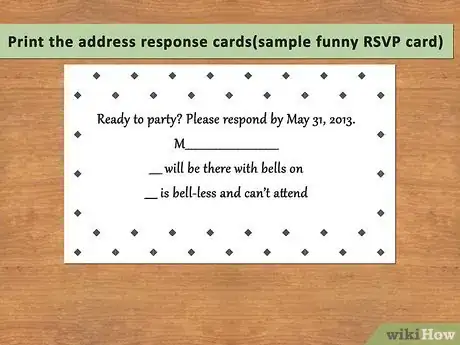
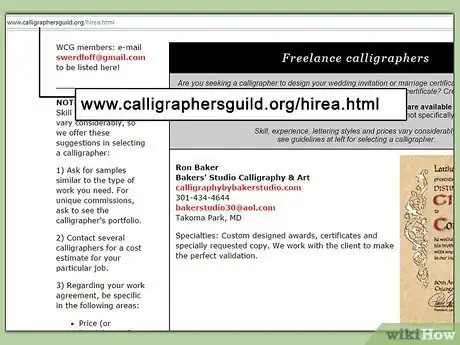
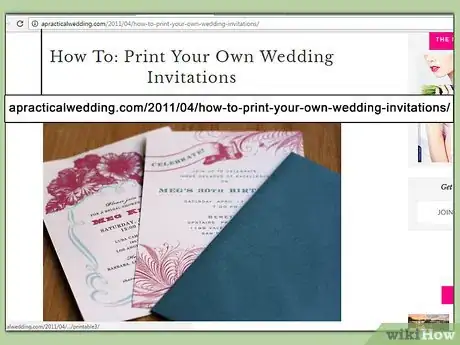
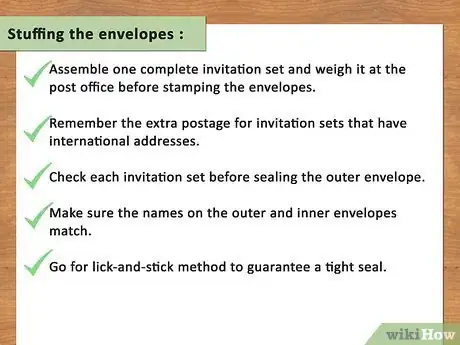

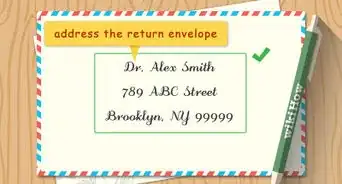








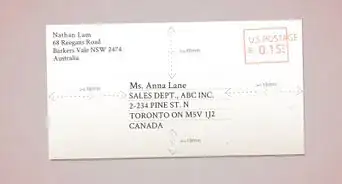

-Step-18-Version-3.webp)








